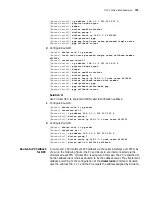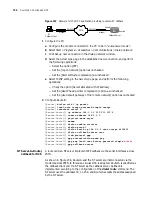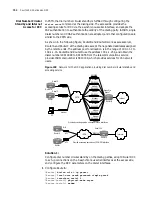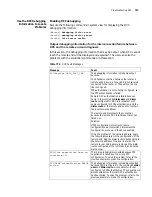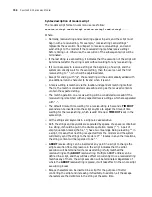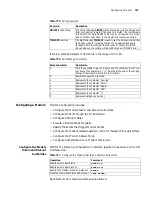
750
C
HAPTER
52: C
ONFIGURING
M
ODEM
Syntax description of modem script
The modem script format in common use is as follow:
receive-string1 send-string1 receive-string2 send-string2......
Where:
■
Normally,
receive-string
and
send-string
appear in pairs, and the script must
begin with a receive-string. For example, “
receive-string1 send-string1
”
represents the execution flow: Expect to receive
receive-string1
, and send
send-string1
to the modem if the received string matches
receive-string1
before timing out. Otherwise, the execution of the subsequent script will be
terminated.
■
If the last string is a send-string, it indicates that the execution of the script will
be terminated after the string is sent without waiting for any receive-string.
■
If it is unnecessary to receive a string at the beginning of a script, and the
system can directly wait for the send-string, then the user can set the first
receive string to "", which will be explained later.
■
Except for ending with “\
c
”, the send-string will be automatically added with
an additional return character to its end when it is sent.
■
A receive-string is matched via the location-independent matching method.
That is, the match is considered successful as long as the received contents
contain the expected string.
■
The match operation on a receive-string will be considered successful if the
receive-string is matched with any expected receive-strings which are separated
with “-“.
■
The default timeout time waiting for a receive-string is 5 seconds.
TIMEOUT
seconds
can be inserted into the script anytime to adjust the timeout time
waiting for the receive-string, which is valid till a new
TIMEOUT
is set in the
same script.
■
All the strings and keywords in a script are case sensitive.
■
Both the strings and keywords are separated by spaces. If a space is contained
in a string, it should be put in the double quotation marks (" "). A pair of
empty quotation marks (that is, "") have two meanings. Being a leading "" in
a script, it means that no string is expected from the modem and the system
will directly send the strings to the modem. If "" locates in any other locations,
the string content will be regarded to be "".
■
ABORT
receive-string
can be inserted at any point in a script to change the
script execution flow. Its presence in the script indicates that the script
execution will be terminated if a received string is fully matched the
receive-string
set by
ABORT
receive-string
. Multiple ABORT entries can be
defined in a script, and they will take effect concurrently. Once a received string
matches any of them, the script execution will be terminated. Regardless of
where the
ABORT
receive-string
is placed, it will take effect in the whole script
execution process.
■
Escape characters can be inserted in a script for the purpose of better
controlling the script and increasing its flexibility. In addition, all the escape
characters are the delimiters in the string at the same time.
Summary of Contents for 3036
Page 1: ...http www 3com com 3Com Router Configuration Guide Published March 2004 Part No 10014299 ...
Page 4: ...VPN 615 RELIABILITY 665 QOS 681 DIAL UP 721 ...
Page 6: ...2 ABOUT THIS GUIDE ...
Page 7: ...I GETTING STARTED Chapter 1 3Com Router Introduction Chapter 2 3Com Router User Interface ...
Page 8: ...4 ...
Page 16: ...12 CHAPTER 1 3COM ROUTER INTRODUCTION ...
Page 34: ...30 ...
Page 60: ...56 CHAPTER 3 SYSTEM MANAGEMENT ...
Page 98: ...94 CHAPTER 6 DISPLAY AND DEBUGGING TOOLS ...
Page 110: ...106 ...
Page 114: ...110 CHAPTER 8 INTERFACE CONFIGURATION OVERVIEW ...
Page 158: ...154 CHAPTER 10 CONFIGURING WAN INTERFACE ...
Page 168: ...164 ...
Page 188: ...184 CHAPTER 13 CONFIGURING PPPOE CLIENT ...
Page 192: ...188 CHAPTER 14 CONFIGURING SLIP Router ip route static 0 0 0 0 0 0 0 0 10 110 0 1 ...
Page 248: ...244 CHAPTER 16 CONFIGURING LAPB AND X 25 ...
Page 320: ...316 ...
Page 330: ...326 CHAPTER 20 CONFIGURING IP ADDRESS ...
Page 362: ...358 CHAPTER 21 CONFIGURING IP APPLICATION ...
Page 374: ...370 CHAPTER 23 CONFIGURING IP COUNT ...
Page 406: ...402 CHAPTER 25 CONFIGURING DLSW ...
Page 408: ...404 ...
Page 452: ...448 CHAPTER 29 CONFIGURING OSPF ...
Page 482: ...478 CHAPTER 30 CONFIGURING BGP ...
Page 494: ...490 CHAPTER 31 CONFIGURING IP ROUTING POLICY ...
Page 502: ...498 ...
Page 508: ...504 CHAPTER 33 IP MULTICAST ...
Page 514: ...510 CHAPTER 34 CONFIGURING IGMP ...
Page 526: ...522 CHAPTER 36 CONFIGURING PIM SM ...
Page 528: ...524 ...
Page 532: ...528 CHAPTER 37 CONFIGURING TERMINAL ACCESS SECURITY ...
Page 550: ...546 CHAPTER 38 CONFIGURING AAA AND RADIUS PROTOCOL ...
Page 590: ...586 CHAPTER 40 CONFIGURING IPSEC ...
Page 599: ...IX VPN Chapter 42 Configuring VPN Chapter 43 Configuring L2TP Chapter 44 Configuring GRE ...
Page 600: ...596 ...
Page 638: ...634 CHAPTER 43 CONFIGURING L2TP ...
Page 649: ...X RELIABILITY Chapter 45 Configuring a Standby Center Chapter 46 Configuring VRRP ...
Page 650: ...646 ...
Page 666: ...662 ...
Page 670: ...666 CHAPTER 47 QOS OVERVIEW ...
Page 700: ...696 CHAPTER 49 CONGESTION MANAGEMENT ...
Page 706: ...702 CHAPTER 50 CONGESTION AVOIDANCE ...
Page 707: ...XII DIAL UP Chapter 51 Configuring DCC Chapter 52 Configuring Modem ...
Page 708: ...704 ...
Page 762: ...758 CHAPTER 52 CONFIGURING MODEM ...




